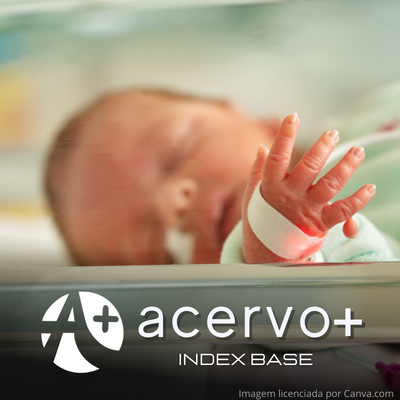Hipotireoidismo congênito
##plugins.themes.bootstrap3.article.main##
Resumo
Objetivo: Analisar as características do Hipotireoidismo Congênito (HC). Revisão bibliográfica: O hipotireoidismo congênito é o distúrbio endócrino congênito mais frequente. Nesta doença, a função dos hormônios que contém iodo é interrompida devido à produção inadequada de hormônio tireoidiano que pode ser resultado de um erro inato do metabolismo da tireoide, defeito na glândula ou deficiência de iodo. Atualmente, é uma das doenças endócrinas mais prevalentes na infância. Acometendo cerca de 1:2.000 a 1:4.000 nascidos vivos. A maioria das crianças com HC nasce com poucos sintomas ou assintomática, sendo diagnosticadas através da triagem neonatal, que foi proposta para permitir um diagnóstico precoce e prevenir o atraso mental, uma das principais complicações do HC. Considerações finais: O HC congênito é a causa tratavél mais comum de retardo mental. Esta é uma doença que requer rastreamento em todos os nascidos vivos entre o 3º e 5º dia de vida através dos testes de triagem neonatal. O tratamento com Levotiroxina deve ser iniciado até no máximo 14 dias de nascimento e a falha no tratamento impõe muitos custos socioeconômicos aos indivíduos, famílias e sociedade.
##plugins.themes.bootstrap3.article.details##
Copyright © | Todos os direitos reservados.
A revista detém os direitos autorais exclusivos de publicação deste artigo nos termos da lei 9610/98.
Reprodução parcial
É livre o uso de partes do texto, figuras e questionário do artigo, sendo obrigatória a citação dos autores e revista.
Reprodução total
É expressamente proibida, devendo ser autorizada pela revista.
Referências
2. BRAGA H, et al. Congenital hypothyroidism as a risk factor for hearing and parents' knowledge about its impact on hearing. J Otol, 2021; 16(2): 71-79.
3. BRITO LNS, et al. Adhesion to treatment by children with congenital hypothyroidism: knowledge of caregivers in bahia state, brazil. Revista Paulista de Pediatria, 2021; 39: e2020074.
4. CHAMMAS MC. Determination of thyroid volume by ultrasound: a valuable tool for the investigation of congenital hypothyroidism. Radiol Bras, 2021; 54(3): VII.
5. CHRISTENSEN-ADAD FC, et al. Neonatal screening: 9% of children with filter paper thyroid-stimulating hormone levels between 5 and 10μIU/mL have congenital hypothyroidism. J Pediatr (Rio J), 2017; 93(6): 649-654.
6. EBRAHIMIPOUR H, et al. Implementing the six sigma model on the treatment of congenital hypothyroidism: An analytical hierarchy process. Med J Islam Repub Iran, 2021; 35: 121.
7. EHSANI R, et al. Evaluation of the developmental outcome in children with congenital hypothyroidism. Caspian J Intern Med, 2021; 12(3): 315-322.
8. FREZZATO RC, et al. Fine motor skills and expressive language: a study with children with congenital hypotyreoidism. Codas, 2017; 29(1): e20160064.
9. GALERA RML, et al. Neonatal screening for congenital hypothyroidism. Rev Esp Salud Publica, 2021; 95: e202101010.
10. HASHEMIPOUR M, et al. Screening of congenital hypothyroidism in preterm, low birth weight and very low birth weight neonates: A systematic review. Pediatr Neonatol, 2018; 59(1): 3-14.
11. HUANG R, et al. An interpretation of "congenital hypothyroidism: a 2020-2021 consensus guidelines update-an ENDO-European Reference Network initiative endorsed by the European Society for Pediatric Endocrinology and the European Society for Endocrinology". Zhongguo Dang Dai Er Ke Za Zhi, 2021; 23(11): 1075-1079.
12. KIESS W, et al. Congenital hypothyroidism. J Pediatr Endocrinol Metab, 2018; 31(6): 595-596.
13. KOPEL J. A global perspective on newborn congenital hypothyroidism screening. Proc (Bayl Univ Med Cent), 2019; 33(1): 137-139.
14. LAU CS, et al. Screening for Congenital Hypothyroidism. Ann Acad Med Singap, 2020; 49(12): 934-936.
15. MINAMITANI K. Newborn Screening for Congenital Hypothyroidism in Japan. Int J Neonatal Screen, 2021; 7(3): 34.
16. SÁNCHEZ AR, et al. Diagnosis and follow-up of patients with congenital hypothyroidism detected by neonatal screenin]. An Pediatr (Engl Ed), 2019; 90(4): 1-8.
17. SARMENTO OJJ, et al. Teste de triagem neonatal: o diagnóstico precoce de doenças metabólicas e genéticas . Rease, 2022; 8(5): 1649-60.
18. SHEN L, DING J. Serological Characteristics, Etiological Analysis, and Treatment Prognosis of Children with Congenital Hypothyroidism. Emerg Med Int, 2022; 2022: 8005848.
19. SOUZA AS, et al. Etiologia do hipotireoidismo congênito e sua distribuição nas macrorregiões do estado de minas gerais. Revista Interdisciplinar Ciências Médicas, 2018; 2(2): 22-28.
20. STAGI S, et al. An Overview on Different L-Thyroxine (l-T4) Formulations and Factors Potentially Influencing the Treatment of Congenital Hypothyroidism During the First 3 Years of Life. Front Endocrinol (Lausanne), 2022; 13: 859487.
21. TAHAN S, et al. Untreated Congenital Hypothyroidism Mimicking Hirschsprung Disease: A Puzzling Case in a One-Year-Old Child. Case Rep Pediatr, 2018; 2018: 9209873.
22. TROTSENBURG PV, et al. Congenital Hypothyroidism: A 2020-2021 Consensus Guidelines Update-An ENDO-European Reference Network Initiative Endorsed by the European Society for Pediatric Endocrinology and the European Society for Endocrinology. Thyroid, 2021; 31(3): 387-419.
23. UTHAYASEELAN K, et al. Congenital Anomalies in Infant With Congenital Hypothyroidism: A Review of Pathogenesis, Diagnostic Options, and Management Protocols. Cureus, 2022; 14(5): e24669.
24. YARAHMADI S, et al. Familial-Related Risks for Congenital Hypothyroidism in Iranian Newborns: A Population-Based Case-Control Study. Int J Endocrinol Metab, 2021; 19(1): e104889.
25. YARAHMADI S, et al. A Success Story: Review of the Implementation and Achievements of the National Newborn Screening Program for Congenital Hypothyroidism in Iran. Int J Endocrinol Metab, 2020; 18(2): e99099.
26. ZHANG J, LI Y. Risk factors for neonatal congenital hypothyroidism: a Meta analysis. Zhongguo Dang Dai Er Ke Za Zhi, 2021; 23(5): 505-512.
27. ZHANG Y, et al. Newborn screening for congenital hypothyroidism: A 13-year observational study. An Pediatr (Engl Ed), 2020; 93(1): 50-52.

